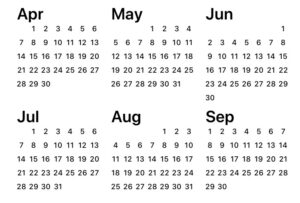If you're born in spring or summer, you may know your April or July birth flower. But did you that the time of year during which you were born can actually determine the way you die?
Yes, that's scary...but true! And, more specifically, your birth month is directly linked to your odds of dying from heart disease! Want to know the worst birth months for heart health? Just keep reading!
Spring and Summer: The Seasons of Heart  Disease
Disease
In a study published in The BMJ, researchers discovered that heart disease is more likely to kill you if you’re born between April and September, the spring and summer months.
Unfortunately, scientists can’t say exactly why these birth months increase your risk. But they do suggest that there’s a connection between your birth month, and your early exposure to seasonal dietary changes, available sunlight and air quality.
To reach these conclusions, they followed 116,911 women who were recruited for the study, and between the ages of 30 and 55 in 1976. Researchers examined the timing of their births, overall causes of death, and deaths caused specifically by heart disease. Every two years, ending in 2014, the women completed health and lifestyle questionnaires.
By the end of the study period, over 43,000 of the women had died. And 8,360 of those women died of issues related to heart disease. While that figure may not seem so surprising, here’s what is: spring and summer babies were significantly more likely to have that cause of death when compared to their peers who were born in the fall. Still, without a direct causal link, the scientists warn us that this study is observation only. After all, they can’t completely rule out other, unmeasured factors that may contribute to the increased risk. Still, if your birthday falls in this range—or even if it doesn’t—it’s important to learn the early warning signs of heart disease, so you can seek treatment at the first sign of a problem.
These are the Warning Signs for Heart Disease
Whether you have an April or July birth flower, and regardless of your risk for cardiovascular disease, you should never ignore these tell-tale symptoms. Especially if they are sudden and unexplained:
1. Chest pain
2. Stomach pain
3. Sweating
4. Leg pain, especially when cramps appear with movement. This could be an early sign of of
PAD (peripheral arterial disease).
5. Arm pain
6. Swollen ankles
(edema), which can indicate circulatory problems or even heart failure.
7. Chronic exhaustion
Treatment Options for Symptom
Luckily for all our July birth flowers out there, we can treat many of these early warning signs of heart disease. When it comes to PAD, our minimally invasive treatments, including angioplasty and atherectomy, can help return blood flow to your outer limbs. In turn, this should
boost your overall circulation, and could even reduce your risk for progressive heart disease.
Got edema? We've got solutions. First, the FDA recently approved a new edema medication, known as Soaanz. It's meant for patients who have heart failure and/or kidney disease. So, if you're not there yet, you may prefer this easy lifestyle solution for leg swelling: eat more zucchini!
It's simple, but effective for minor cases of edema. Because this veggies has water contents between 90 and 95%, it can help you stay hydrated. And, while you may think adding more water to your body will make your swelling worse, the opposite is true. Because, when you add extra hydration to your system, your body may relax its hold on other water sources. Which could help ease water retention and swelling.
Remember, on their own, any one of these symptoms should be a sign that it’s time to discuss your heart with a healthcare provider. But, in combination, consider these symptoms a potential emergency. Seek medical attention right away. And, if you're noticing early warning signs of PAD or other symptoms of vein disease,
schedule an immediate consultation with our
team of Houston vein specialists!
Source Page: https://texaseva.com/sources/
 Disease
Disease